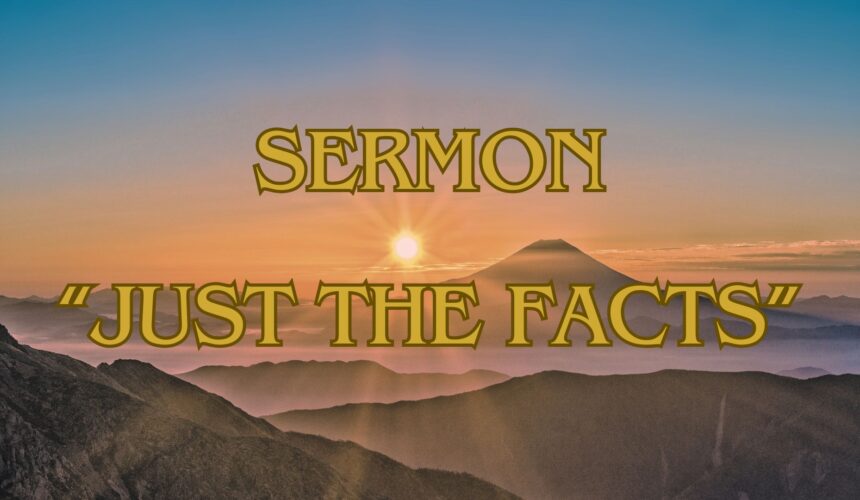Easter Sunday
April 20, 2025
Luke 24:1 – 12, 36 – 40
I used to know this guy who had a standard way of greeting me whenever we hadn’t seen each other in a while. He would say, “What do you know for sure?”
The question always put me in kind of a philosophical quandary. I’d head down a rabbit hole of questions: what do I know for sure? Do I actually know that I’m here talking to this guy right now? How do I know? Do I even know I’m real? Whenever my friend asked me the question, I’d end up saying, “Not much.”
Lately, it kind of seems like our whole society is caught up in the same kind of philosophical quandary I was. What’s true? What’s a fact? How do we know?
People have always argued over what the facts are. But nowadays, we don’t even seem to be able to agree on the definition of a fact, let alone agree on where we should get the facts on anything. Nowadays, at least to me, it feels like almost any statement, no matter how straightforward, has all these implications for politics and power and identity and whose side we’re on in the ongoing low-intensity (and sometimes high-intensity) conflict in which we’re living. Lately it sometimes feels like if I were to say it’s a nice day, somebody would probably respond “sure, if you’re a right wing nut job!” I would even guess that just my bringing this problem up has maybe raised tensions a little bit in the room this morning.
Now, if I have raised the stress level in the room, don’t worry. I’m not here to wreck your Easter by going off on some political rant. That’s not my point. My point is, we live in weird times. We live in a time where every conversation has an element of risk – because the simplest sentence has the potential to go sideways and become a bitter argument.
Maybe I’m exaggerating a little. Maybe I’m hypersensitive, because I do kind of make my living by talking, and it often feels like I’m walking on eggshells. But I don’t think I’m exaggerating much. And if that’s true, then it seems like an especially brazen move to gather here on Easter Sunday to celebrate the truth in a story of a man being resurrected after death.
I imagine if I took a poll of all of us in the room right now and asked the question of why we are here today, we might hear all kinds of reasons to come to church on Easter morning: to celebrate new life, to take joy in the return of spring, to be with family and friends, to appreciate beauty, to hear great choir and organ and piano and brass music, to remind ourselves of the value of a church community, to watch children hunt Easter eggs and enjoy chocolate bunnies and Peeps – and probably a whole lot of other reasons too. And as far as I’m concerned, those are all really good reasons to be here. I’m delighted we are. It’s great to be here with all of you.
But at the heart of this annual Easter celebration is a story that might kind of strain credibility, a story that has been accused now and then of not being entirely factual. A first-century peasant Rabbi starts a popular religious movement. People flock to him, especially disadvantaged and marginal people and outcasts who’ve been told their entire lives in a hundred different ways that they have no real value. Over time, the peasant Rabbi’s movement grows. Rumors begin to spread about him, first in whispers, then in loud and joyful voices: this is the One. This is the One to redeem us. This is the One God has sent to deliver us from crushing poverty, from oppression, from the Roman Empire’s military occupation. This is the One through whom God will triumph over evil at last.
Now of course, the Romans and for that matter the temple leadership in Jerusalem, they can’t let that kind of talk go unchallenged. So eventually, as almost anyone living around Jerusalem at the time could probably have predicted, the Roman regional Governor and local leaders and even the Holy Land’s puppet dictator King conspire to kill the upstart Rabbi in the most public and humiliating and brutal way possible. They take him down and let his death stand as a warning to anyone who is deluded enough and audacious enough to oppose their power.
But somehow, the plan backfires. His followers keep making this bizarre claim that they’ve seen him, alive and in the flesh. He’s not a ghost or a vision or a dream. He’s not the product of wishful thinking. He’s not some disembodied spirit. In the Biblical stories of resurrection, Jesus is a real flesh and blood person. He touches people. He breaks bread and serves it. He breathes deeply. He walks along the road with his friends and talks to them. He sits down and eats with them. Mary Magdalene reaches out and takes hold of him. He even grills fish on a fire and serves a meal to his friends. The Gospel stories of the resurrected Jesus are very embodied, very physical. And in that physicality, the stories make a very powerful claim: the plot to kill him, with all the might of the world’s most fearsome and advanced Empire behind it, all the Empire’s will to power and domination, that plot has failed. Fear has failed to do its job. Intimidation has failed to do its job. State sponsored terror has failed to do its job. Death, that seemingly most reliable of realities, has failed. Death does not have the last word.
How about that as a claim to truth? Pretty crazy, huh? You can believe it or not. But does that claim have implications for power? Does it say a few things about hope, about the way we live our lives?
I kind of think so.
Maybe one thing it says is the resurrected Christ is to be found right here in our lives. You know, when the Apostles meet Jesus after his crucifixion, they’ve had a truly awful few days. They’ve watched their beloved teacher be brutalized and die; they’re terrified and hiding, looking over their shoulders because they’re afraid they might be next. But when they meet him in his resurrection, they’re not doing anything extraordinary. They’re in a house talking together. They’re fishing, because they’re fisherman and they’ve got to make a living. They’re walking together down a road. They meet him while doing very ordinary, everyday things. Which is, I think, one way of saying that we meet God right here: in our lives, in the flesh, in our physical, embodied, mundane existence, which turns out to be not so mundane after all. The resurrection stories tell us that human life is where God can be found; that human life is holy. Those early Christians soon recognized that anyone we meet might be the Christ in the stranger’s guise.
So if we want to find God, if we want to find hope and strength and courage in times that too often lead us to despair and alienation and a sense of helplessness, we don’t need a spiritual master to guide us, although that can help. We don’t need to make a pilgrimage to some Holy Place, although that can help. We don’t need to read a special book on Christian spirituality or engage in a special meditation or prayer practice. All those things can help. But in the end, maybe all we need – in a world that’s far too loud and angry, where a thousand voices are screaming at us all the time, telling us to be outraged and blame each other for all that’s wrong – maybe all we really need to find God is the ability to gather together, to take joy in one another, to shoulder each other’s burdens and celebrate each other’s victories, to share a meal and listen to one other deeply and appreciatively. Maybe then we will come to see the resurrected Christ in our lives, where the resurrected Christ has been the whole time.
There’s something else about these Gospel stories about Jesus resurrection after his followers have seen him die that I think is especially worth noticing.
There are moments when the Apostles doubt even the physical evidence they can touch and see and hear. He’s right in front of them, physically embodied, but it’s so improbable that they still can’t believe it. And when they doubt even those experiences, Jesus has a simple answer. He says, “touch my wounds. Look at my scars.” In the Gospel of John, he says to Thomas, “look at my hands. Put your hand in my side. Believe.” In the Gospel of Luke, the version of the story we heard this morning, Jesus appears to his disciples and they’re terrified. They think he’s a ghost. But he says, “Look at my hands and my feet…Touch me and see…a ghost does not have flesh and bones as I have.” And then Luke says, “he showed them his hands and his feet.” He shows them his wounds.
It’s a little surprising, really: the Gospel writers believed he was God in human form. This is especially clear in the Gospel of John, but it shows up in all of them. They believed he had defeated even death. They believed that in the resurrection, he had come into his full power and his glory. So when he’s resurrected, you’d think his wounds would be gone. But they’re not. His wounds are how his followers know he’s real. Even these marks of human cruelty and oppression and pain and abuse of power, even they are redeemed and used for God’s purposes of healing a fearful and despairing world.
I think that points to another truth the resurrection stories contain. In God’s Kindom, it God’s reality (which is also our reality), in God’s economy, nothing is wasted. Even our wounds, even our worst moments, can be enfolded into God’s purposes and used for healing: for us and through us for all of God’s creation.
We can choose to believe it or not. We all get to decide what we think are the facts.
But this story says, and I believe, that love defeats death; that the truth is not to be found in despair or meaninglessness or heat death and the grey soup of maximum entropy, but life and rebirth and renewal and hope. Hopelessness and despair and alienation and fear: those things feel real while they’re happening to us, and I would never tell anyone who’s feeling them that they’re not to be taken seriously. But they’re not the last word. The ultimate, final word, God’s reality, our reality, right here, in this flesh and blood world that, yes, does injure us now and again: the final reality is resurrection, joy, celebration, faith, hope, love, praise, community. (And you know, chocolate bunnies aren’t so bad either. I’m not so sure about Peeps; that’s a deeply contentious subject and you’ll have to find your own way.)
It takes a certain courage to invest ourselves in God’s reality, in God’s economy. It can be hard. I don’t know about you, but I often feel defeated, hopeless; I often feel like giving up. But maybe gatherings like this one, and all the fellowships and communities we form and invite God into, can help remind us of what’s really true. Maybe those gatherings and the communities that make them possible can carry us through those moments of defeat and alienation – because we know that those awful moments are not the last word, not ever.
I believe that we’re called now, all of us, to the courage of joy and the courage of delight in God’s presence: in one another, in community, in creation. That’s how we reflect the truth of the resurrection. That’s how we find our new life. That’s how we are resurrected.


